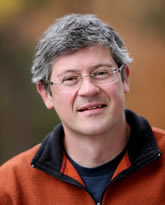Markus Babst
Professor of Biology and Director of Center for Cell & Genome Science
Ph.D. University of Zurich
Graduate Program Membership:
Office/Building: CSC 120
Phone: 801-587-7603
Email: m.babst@utah.edu
Research Statement
In eukaryotes, the 'multivesicular body' (MVB) pathway delivers transmembrane proteins into the lumen of the lysosome for degradation. This degradation pathway is essential for regulating cell surface protein composition, nutrient uptake, cell communication and immune response. Disruption of the MVB sorting pathway can cause significant problems for the cell in responding to extracellular cues and results in pathogenic states such as uncontrolled cellular proliferation in cancers and neurodegenerative diseases. Several multiprotein complexes, called the ESCRTs, execute the sorting of proteins into the MVB pathway. Using yeast as a model system my laboratory combines genetics, cell biology and biochemistry to gain insight into the function of the ESCRT proteins.
Research Interests
General Interests
Specific Interests
- Membrane protein trafficking
- Regulation of the endosomal system in yeast
Selected Publications
- Shestakova, A., M. Curtiss, B.A. Davies, D.J. Katzmann, and M. Babst. 2013. The linker region plays a regulatory role in the assembly and activity of the Vps4 AAA ATPase. J. Biol. Chem. 288(37):26810-26819.
- Mageswaran, S.K., M.G. Dixon, M. Curtiss, J.P. Keener, and M. Babst. 2013. Binding to any ESCRT can mediate ubiquitin-independent cargo sorting. Traffic 15(2): 212-229.
- Babst, M. 2014. Quality control at the plasma membrane: one mechanism does not fit all. J. Cell Biol. 205(1): 11-20.
- Mageswaran, S.K., N.K. Johnson, G. Odorizzi and M. Babst. 2015. Constitutively active ESCRT-II suppresses the MVB sorting phenotype of ESCRT-0 or ESCRT-I mutants. Mol. Biol. Cell 26(3): 554-568.
- Kim, H.J., M.Y. Jeong, T.J. Parnell, M. Babst, J.D. Phillips and D.R. Winge. (2016). The plasma membrane protein Nce102 implicated in eisosome formation rescues a heme defect in mitochondria. J. Biol Chem. 291(33): 17417-26.
Courses Taught
- Biol 5210: Cell Structure and Function

